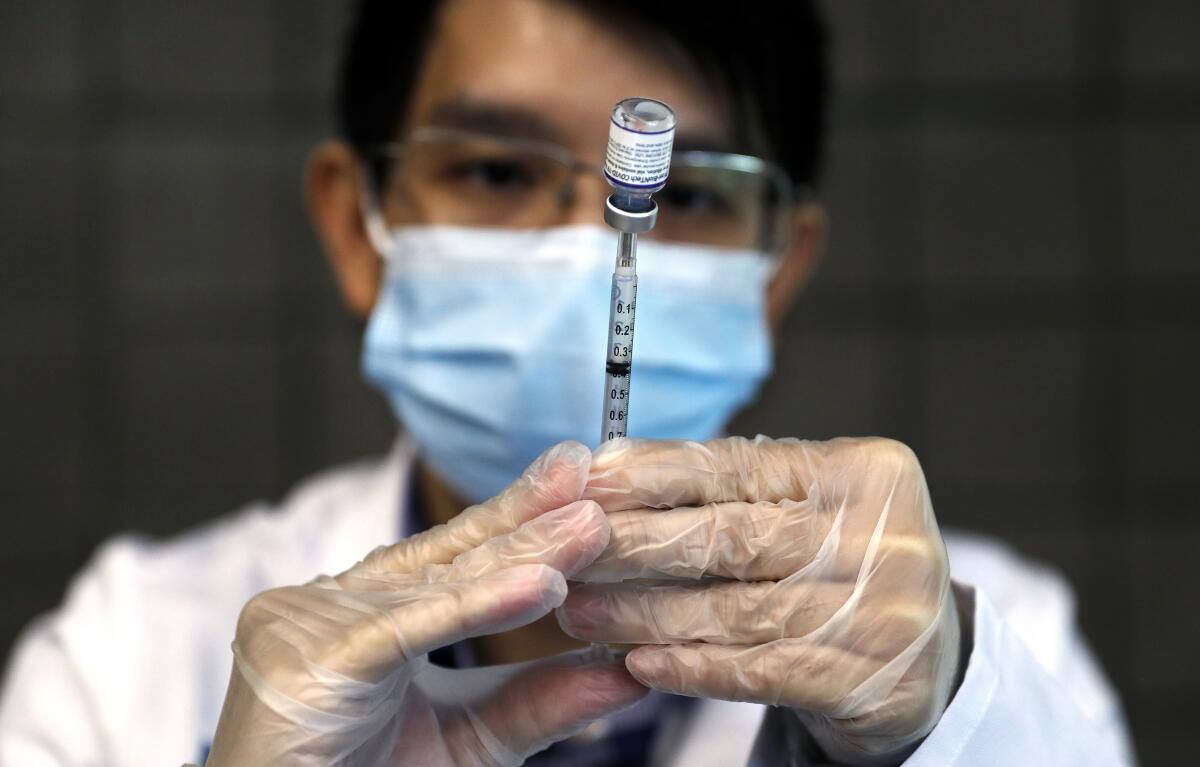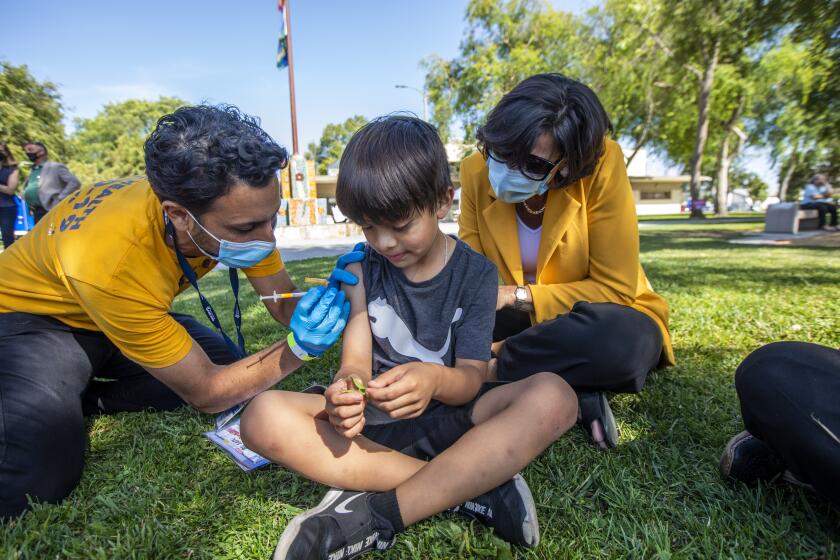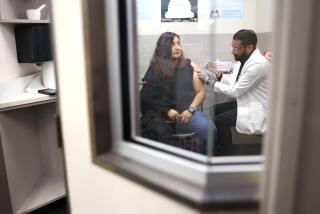More COVID shots are coming. Will a weary public be more interested this year?

- Share via
A new coronavirus shot will be available starting this week, but the big question is how many people will get one.
Attitudes about COVID-19 are clearly shifting, as is to be expected since it long ceased to be the sort of suffocating public health threat that ground the globe to a halt. But health officials note that vaccines are a major driver of that progress, and continued inoculations — much like a typical flu shot — can help keep the coronavirus confined.
It’s clear that vaccines, once so desired that hopefuls endured hours-long waits or even hit the road in hopes of securing the shots, have become a harder sell as the pandemic eased and people moved on with their lives. Deaths and serious illnesses are down.
That’s not to say there’s no appetite for the latest targeted batch of shots, however.
The CDC recommended that much of the American public, everyone age 6 months and up, receive an updated COVID-19 vaccine. The shots could be available this week.
Attitudes about vaccination
According to survey results released this week, Americans appear more inclined to get the latest COVID-19 vaccination than they were last year. The U.S. Centers for Disease Control and Prevention this week recommended that virtually all Americans — ages 6 months and up — get a fresh vaccine dose this autumn using a new formula designed against an Omicron subvariant that was dominant earlier this year.
Just 21% of adults nationwide received the last updated COVID-19 shot that was introduced a year ago. But a survey of adults taken in August, the results of which were presented by the CDC this week, suggest that about 43% of adults plan to either probably or definitely get this latest COVID-19 vaccine.
Such uptake would be more in line with that of the annual flu shot. Survey results suggest 47% of U.S. adults got the flu shot during the 2022–23 flu season.
Doctors say it remains important that people stay up to date on their vaccinations. While the risk of dying from COVID-19 has fallen since the early months of the pandemic — thanks to vaccinations, anti-COVID drugs like Paxlovid, years of natural immunity and a slower evolving virus — deaths can still happen.
Officials had expressed concern that BA.2.86, or Pirola, might be able to more easily infect those who had received older vaccines or had caught the coronavirus before.
“In those with and without underlying conditions, there was no group that clearly had no risk of severe illness,” Megan Wallace, a CDC epidemiologist, said during Tuesday’s meeting of the agency’s Advisory Committee on Immunization Practices.
There is some hope that as COVID-19 vaccinations become more routine, like the flu shot, there will be less fatigue. Large majorities of Americans have completed their primary COVID-19 vaccination series, including 94% of U.S. seniors and 79% of adults.
For most, that primary series entailed a two-dose regimen of either the Moderna or Pfizer-BioNTech vaccines. However, uptake on subsequent booster or additional doses has lagged behind those more robust top-line figures.
Today, most people who have never been vaccinated no longer need to get a two-dose primary series to be considered inoculated. Now, an unvaccinated person who is at least 5 years old needs to get only one shot to be considered current on their vaccination.
Only unvaccinated babies and young children, ages 6 months to 4 years, will need either two doses of the updated Moderna vaccine or three doses of the updated offering from Pfizer-BioNTech.
Officials also no longer use the term “boosters” to describe the latest vaccination, instead calling it an updated COVID-19 vaccine.
In a Kaiser Family Foundation poll published in April, 32% of adult respondents said they were “very” likely to get a COVID-19 vaccine offered annually, like the flu shot; while another 21% said they were “somewhat” likely.
The Huntington Beach City Council voted to ban implementing COVID-19 vaccine and mask requirements in the city.
Vaccine trust
Despite a robust safety record, Americans are less confident in the safety of COVID-19 vaccines than they are other routine adult vaccines and the flu shot.
About 66% of adults think routine adult vaccines as either completely or very safe, and 27% say they are somewhat safe. For the flu shot, 64% consider it completely or very safe, and 26% consider it somewhat safe, according to a survey conducted in August whose results were presented by the CDC.
But for the COVID-19 shot, 49% of adults consider it completely or very safe, and 30% consider it somewhat safe.
Among those who didn’t get last year’s updated COVID-19 shot, the possibility of unknown serious side effects was cited as a key reason.
The CDC says the COVID-19 vaccines are safe and effective. More than 670 million doses had been administered through March 1, the CDC said, “under the most intense safety monitoring in U.S. history.”
“The benefits of COVID-19 vaccination outweigh the known and potential risks,” the CDC says.
Notably, healthcare providers are slightly more likely to recommend other routine vaccinations to adults than they do for COVID-19. Among adults, 72% said their healthcare provider suggested they get the flu shot, but just 56% mentioned the COVID-19 vaccination.
Encouraging doctors to routinely suggest an updated COVID-19 vaccination — possibly made easier by a simpler, once-a-year time frame for most people — could help boost vaccination rates, experts say.
The CDC said that in one study, the risk of cardiac complications — including myocarditis, an inflammation of the heart muscle — was actually higher among adolescent males age 12 to 17 after a coronavirus infection than after getting a COVID-19 vaccination.
In Los Angeles County, the number of new COVID-19 outbreak investigations at work sites tripled in the last month, reaching 73 for the 30-day period that ended Sept. 1.
COVID-19 impact remains
From last October through the end of April, there were more than 70,000 COVID-19 deaths nationally, about 200,000 fewer than during the same time period the prior year, but still twice the typical number of annual flu deaths.
So far this calendar year, about 25,000 people ages 65 and up have died from COVID-19, as have about 2,800 adults between the ages of 45 and 64, and about 450 people ages 20 to 44, according to the CDC. There have been 36 deaths among those ages 5 through 19; 18 deaths among those ages 1 to 4; and 26 deaths among those younger than 1.
“COVID-19 burden is currently lower than at previous points in the pandemic, however, the absolute number of hospitalizations and deaths is still high,” Wallace said.
Even people with no underlying health conditions can still die from COVID-19.
In order to move through a world where the coronavirus is endemic, we need a reliable way to assess our individual level of immunity. Here’s how we can.
New analysis of recent COVID-19 data confirm that “there are deaths, including in children, including in those without chronic conditions,” said Dr. Matthew Daley, a pediatrician and research expert in vaccines who is also a member of the CDC Advisory Committee on Immunization Practices. “And my perception is that that those deaths are vaccine preventable.”
Most people who are dying from COVID-19 are not current on their vaccinations.
There was some debate at this week’s CDC advisory committee meeting over the merits of how strong a recommendation the agency should make — whether the recommendation for new COVID-19 vaccinations should be for virtually all Americans age 6 months and up, or more limited to seniors and other higher-risk groups.
A strong majority, 13 out of 14 voting members, favored a universal recommendation.
A modeling scenario showed that a universal vaccine recommendation by the CDC, compared to just suggesting those ages 65 and older get vaccinated, “is projected to prevent about 200,000 more hospitalizations, and 15,000 more deaths, over the next two years,” Wallace said.
The law was intended to protect patients from physicians who gave advice they knew to be false or misleading. But many doctors feared it was too vague.
Public concerns lessen
People’s feelings about the pandemic have changed over time, with more Americans saying the coronavirus situation is getting better.
In August, just 3 in 10 American adults reported being very or moderately concerned about getting COVID-19, according to a survey made public by the CDC this week. In a March survey from Monmouth University, half of respondents said they would be very or somewhat concerned about a family member getting COVID-19.
How people feel about COVID varies by race and ethnicity, according to survey data presented by the CDC. Among white adults, 38% said they were “not at all” concerned about getting COVID-19, the highest share of any racial or ethnic group. By comparison, 26% said they would be moderately or very concerned.
Black adults were the most worried about getting COVID-19, with 41% saying they would be very or moderately concerned, while 27% said they were “not at all” concerned.
Among Latino adults, one-third said they were “not at all” concerned about getting COVID-19, while a little over a third said they’d be moderately or very concerned.
Los Angeles County officials said they have no plans for new public mask mandates — a sign of how COVID-19 policies have changed in the back-to-normal era.
“Those living in urban areas reported more concern over getting COVID-19 than those in suburban or rural areas,” Wallace said. Urban residents are more likely to believe in the vaccine’s safety — 51% believe it’s completely or very safe — compared to rural residents, 37% of whom think the same, the CDC survey found.
Income also matters. Concerns about getting COVID-19 decrease as income increases, Wallace said. It is wealthier people who have the most confidence in vaccine safety, with about 57% of people making $75,000 or more saying the COVID-19 vaccines are very or completely safe, while 35% of people making under $25,000 said the same.
Vaccine distribution refinements should make administering vaccinations easier. There will be smaller minimum order quantities and single doses in vials. This “is likely to reduce wastage, eases logistics and helps with storage capacity limitations,” Wallace said.
More to Read
Sign up for Essential California
The most important California stories and recommendations in your inbox every morning.
You may occasionally receive promotional content from the Los Angeles Times.





















